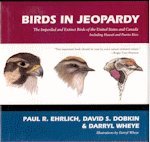Background
Dobkin, David Shabsi was born on May 17, 1950 in Washington, District of Columbia, United States. Son of Harry Israel and Gertrude Madeline (Rosengarten) Dobkin.


(This book presents the population status, current managem...)
This book presents the population status, current management, and conservation needs of 144 species of migratory landbirds that breed within what the US Forest Service terms Region 1 - a vast area that includes all of Montana and North Dakota, the northern half of Idaho, the northernmost portions of Wyoming and South Dakota, and the easternmost slice of Washington.
http://www.amazon.com/gp/product/0893011681/?tag=2022091-20

( As the human population skyrockets and the toxic impact...)
As the human population skyrockets and the toxic impact of human society spreads, the natural habitats of birds degrade and diminish and the bird populations decline. Two hundred years ago, when the United States and Canada were home to less than 5 million people, they were also home to some 650 species of birds. Today, more than 280 million people live there, and 33 bird species have already been driven to extinction and well over 150 are in danger of extinction in all. Or parts of their range. This book, organized and written by the authors of The Birder's Handbook, and enriched by 191 strikingly beautiful color paintings illustrating all of the birds treated, is the first concise, authoritative review of the status of the birds currently imperiled in the United States and Canada - those that are federally listed as Endangered or Threatened and those that are listed by the National Audubon Society as suffering local or regional or. Widespread decline. It also treats the birds that have been driven to extinction in the past two centuries, since the stories of their somber fates can help us learn how to save the other birds that are in jeopardy. Because birdwatchers and others are showing increased interest in the tropical birds that survive in Hawaii and Puerto Rico, the book includes separate sections on the imperiled and extinct birds of those areas. Hawaii is of special importance: because it has. Seen so many extinctions just in the years since Cook's arrival (23 species and subspecies), it provides a laboratory for studying the impact of civilization on birds in the wild. The individual texts - written in clear, non-technical language - cover requirements for successful nesting and feeding; worldwide and North American breeding range, wintering range, and imperiled portions of range; current population estimates (for Threatened and Endangered birds); behavioral. And other factors pertinent to conservation; former and/or current threats associated with decline; current status of imperilment; federally funded recovery plans; and the date of last sighting, in those desperate cases where extinction is imminent or already a fact. In the last century, coal miners took canaries into the mines, reasoning that if poisonous gases were present, the birds would give warning by succumbing first. Now birds are serving as miners' canaries once. Again. In the language of ecology, they are good indicator species, warning us that too many people, unbridled consumption of wildlands and other natural resources, faulty technologies, and irresponsible disposal of chemical and other wastes threaten not just birds but ourselves and every other living thing. In our daily lives we seldom see the terrible effects of these forces but they are demonstrated every day by scientific surveys of the environment, around the world.
http://www.amazon.com/gp/product/0804719675/?tag=2022091-20
ecologist science administrator zoology educator
Dobkin, David Shabsi was born on May 17, 1950 in Washington, District of Columbia, United States. Son of Harry Israel and Gertrude Madeline (Rosengarten) Dobkin.
Bachelor, George Washington University, l972; Master of Science, Colorado State University, l975; Doctor of Philosophy, University of California, Berkeley, l983.
Graduate research assistant, International Biological Program, Fort Collins, Colorado, l974-75; lecturer biological station, University of Michigan, Pellston, l975; ornithology curatorial assistant, Museum Vertebrate Zoology University of California, Berkeley, l976; graduate research assistant, University of California, Berkeley, l978-8l; instructor, Coyote Point Natural History Museum, San Mateo, California, l982-83; postdoctoral research fellow department biological science, senior ecologist, acting assistant professor, Stanford (California) U., l983-86; assistant professor zoology, Rutgers University, Camden, New Jersey, 1986-1992; founder, executive director, High Desert Ecological Research Institute, Bend, Oregon, since 1993. Master bander United States Fish and Wildlife Svc.
(This book presents the population status, current managem...)
( As the human population skyrockets and the toxic impact...)
(The natural habitats of birds have degraded & diminished ...)
Member endangered and nongame species advising committee State of New Jersey, 1988-1991,nongame wildlife task force State of Oregon, since 1991. Member American Association for the Advancement of Science, American Ornithologists Union, American Society Zoologists, Ecological Society American, Society for Conservation Biology, Cooper Ornithological Society (board directors since 1996).
Married Donna RoseLatzko, April 24, 1980. Children: Gabriel, Adria, Elliot.
